The DeepCool AK620 Digital CPU Cooler Review: Big, Heavy, and Lit
by E. Fylladitakis on March 28, 2024 9:00 AM EST- Posted in
- Cases/Cooling/PSUs
- Deepcool
- Cooler
- RGB
- CPU cooler
- Air Cooling
Testing Results, Maximum Fan Speed
To begin with, we are having a look at the DeepCool AK620 Digital with its two FK120 fans running at their maximum speed. We measured the top speed of the fans while attached to the heatsink at 1920 RPM, measurably higher than their 1850 RPM unobstructed maximum speed.
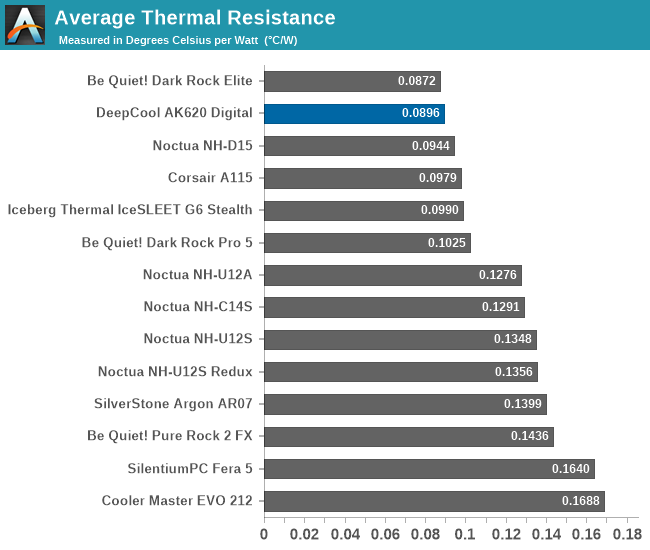

| Core Temperature, Constant Thermal Load (Max Fan Speed) |
Going by both thermal resistance and delta temperatures, the DeepCool AK620 Digital CPU Cooler is on par with the best in the game when it comes to cooling, but it's a bit louder than average. It hits an impressive 0.0896 °C/W thermal resistance at a max fan speed of 1920 RPM, making it clear it's built for heavy-duty use. Though it seems to be in the same league as other high-end coolers, the catch is its fans are faster.
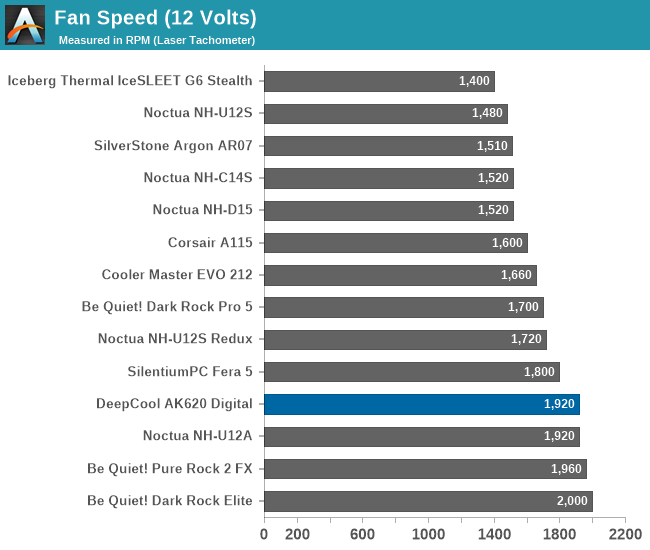
When it comes to noise, the AK620 Digital isn't exactly whisper-quiet, clocking in at 39.7 dB(A) at full throttle. Despite the noise, it's still a solid choice for those prioritizing cooling performance, showing DeepCool's attempt to balance brute cooling force with noise control, even if it leans a bit more towards the loud side.

Testing Results, Low Fan Speed
In this test we are switching things up a bit, taking a look at the cooler’s performance with the FK120 fans taken down to half speed.
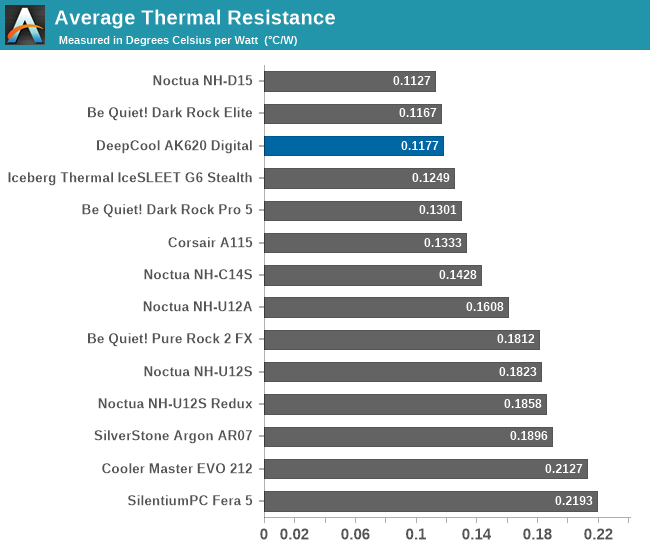
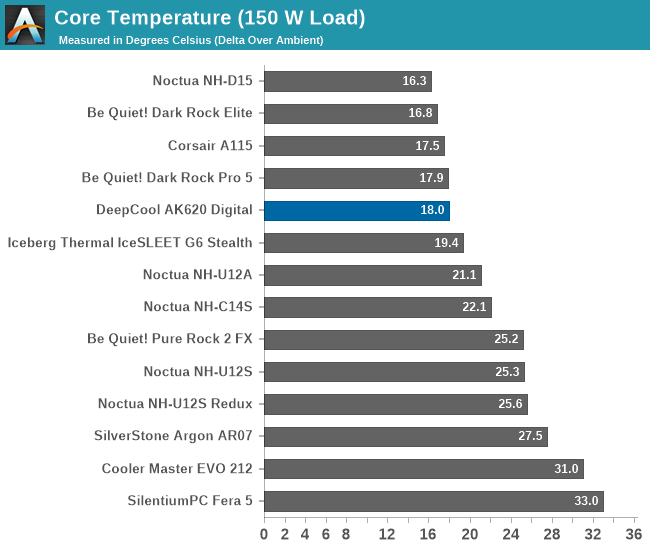
| Core Temperature, Constant Thermal Load (Low Fan Speed) |
When the fan speed of the DeepCool AK620 Digital CPU Cooler is adjusted down to 1000 RPM, there is expectedly a noticeable impact on its cooling capability, though a smaller one than what we initially expected from a cooler with low pressure fans. The thermal resistance at this lower speed registers at 0.1177 °C/W, which, despite the decrease, still places the cooler among the best in terms of thermal efficiency within its category. This level of performance under reduced fan speed suggests that the huge mass of the cooler itself, as well as the great heat exchange area, allow it to maintain great figures even when the airflow is limited.
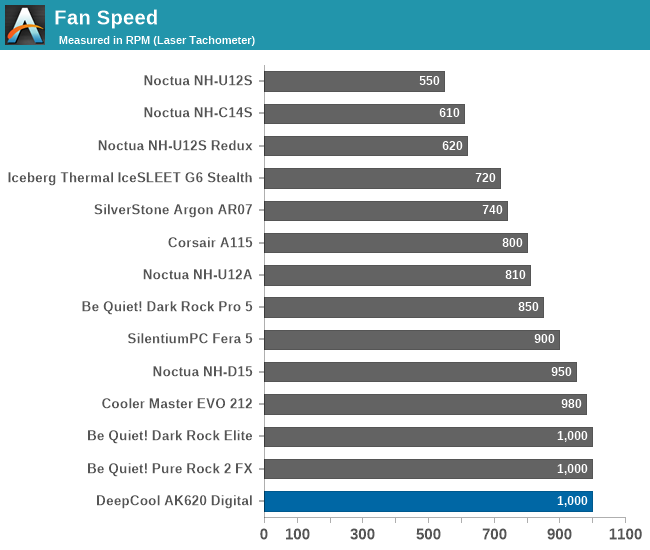
However, even though the speed of the fans has been halved, the noise level of 34.6 dB(A) is somewhat louder compared to some competitors. Despite this increase, the noise produced at this speed is still within a comfortable listening range for everyday use, indicating a well-thought-out balance between noise and performance. This suggests that while the AK620 Digital might produce more sound pressure than some of its quieter rivals, it is not so much as to be a problem.
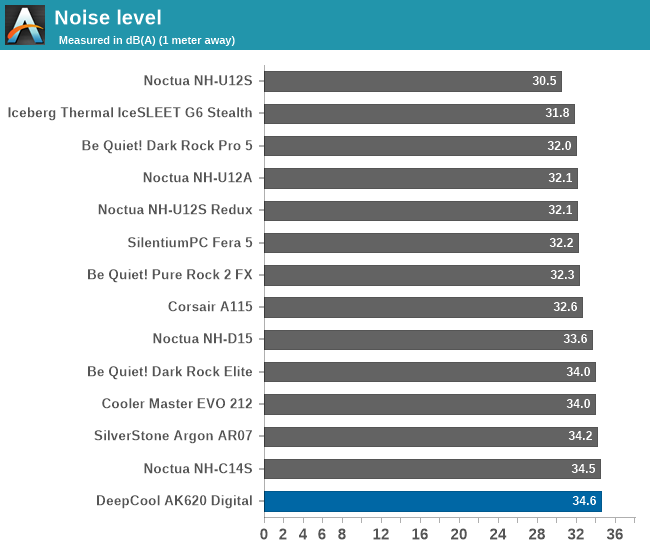
Thermal Resistance VS Sound Pressure Level
During our thermal resistance vs. sound pressure level test, we maintain a steady 100W thermal load and assess the overall performance of the coolers by taking multiple temperature and sound pressure level readings within the operating range of the stock cooling fans. The result is a graph that depicts the absolute thermal resistance of the cooler in comparison to the noise generated. For both the sound pressure level and absolute thermal resistance readings, lower figures are better.
This chart reveals where the DeepCool AK620 Digital falls compared to similar designs. Despite its exceptional thermal performance, the AK620 lands right amongst the rest of the similarly sized coolers due to its higher noise levels. Generally, it matches the performance of the best air coolers when the fan speed is high but falls behind when the fan speed is low, not really because its thermal resistance is high but because the noise is, which pushes the chart line upwards. These results suggest that the AK620 Digital can perform exceptionally if required but cannot reach the dead-silent noise figures that other offerings can.











22 Comments
View All Comments
Oxford Guy - Saturday, April 13, 2024 - link
'DeepCool’s engineers have designed the fin arrays to be quite dense.''The fans have a maximum rotational speed of 1850 RPM and are high airflow/low pressure designs, with numerous small blades. This type of fan is typically used when the expected airflow resistance is minimal.'
It's amazing that companies continue to push out incompetent designs for products that have been around for a very long time. Reply
NorthRocks - Tuesday, April 16, 2024 - link
I've got couple of Noctua NH-D15 (two fan models) still in use. Although results varies slightly depending on reviewer and methodology, it seems there's very little reason to upgrade to newer competitors. Reply